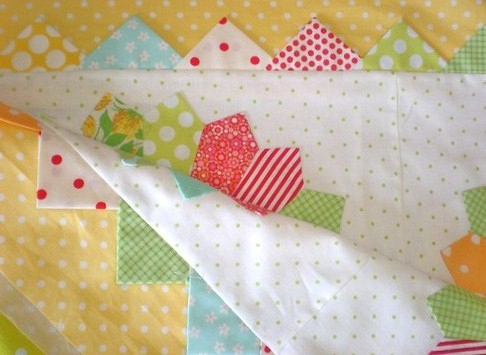Prairie points are folded pieces of fabric that embellish a quilt. Although they have been discovered on quilts dated back to the 1800’s, they weren’t actually called “prairie points” until the mid 1900’s. These folded triangles come in all sizes! Traditionally prairie points can be found framing the edge of the quilt. Some quilters like to call them a variation of a traditional quilt binding; they can be used in addition to a regular binding or as a replacement. Prairie points can also be used within a quilt. They can border individual quilt blocks and appliques, or they can be used within a block.

Photo via Sew Take a Hike

Photo via Mary Dugan
Why use prairie points? They add unique visual interest to a project. A simple quilt can be perked up by this treatment! Prairie points add that extra dimension to a quilt, and this tactile feature is loved and appreciated by all ages.
There are two different types of prairie points: centerfold and quarter fold. To create a centerfold prairie point, begin with a square of fabric. Fold the square in half, leaving the folded side on top. Then grab the two upper corners and fold them down to the center, lining the raw edges along the bottom. This creates a neat little center fold in the prairie point, which is highlight of this type of triangle. When arranging these points in a row, the corners of the triangles are overlapped.

Photo via My Patchwork
To create a quarter fold prairie point, start again with a square of fabric. Fold it in half diagonally to create a triangle. Fold this triangle in half again, matching up the folded corners. Now you have a quarter fold prairie point that has an opening in the side! When arranging these kinds of points in a row, nest them together by placing the corner of one triangle into the fold of the next.
Another popular way to create prairie points is to make them in a continuous manner. By using a strip of fabric, a little cutting, and a bit of folding, you can make a continuous strip of prairie point triangles! What is the big advantage for making them this way rather than individual points? All of the triangles are already connected and lined up for you! You don’t need to worry about them being uneven when you sew them onto your project.

Photo via Diary of a Quilter
There are many tutorials available online for continuous prairie points. Head on over to the Bluprint pattern section to find some great quilt projects that incorporate prairie points!

Share tips, start a discussion or ask one of our experts or other students a question.
No Responses to “Exploring Prairie Points Quilting Techniques”